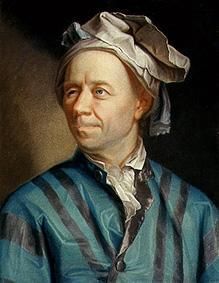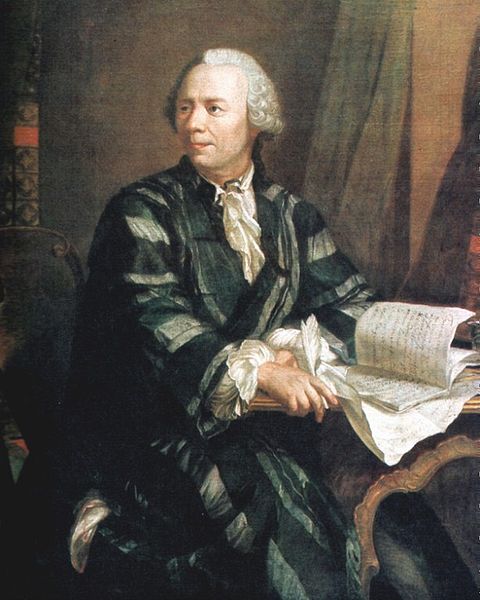<Back to Index>
- Mathematician Leonhard Paul Euler, 1707
- Painter Leonardo di ser Piero da Vinci, 1452
- Chairman of the Presidium of the Supreme Soviet Nikita Krushchev, 1894


Leonhard Paul Euler (15 April 1707 – 18 September 1783) was a pioneering Swiss mathematician and physicist who spent most of his life in Russia and Germany.
Euler made important discoveries in fields as diverse as infinitesimal calculus and graph theory. He also introduced much of the modern mathematical terminology and notation, particularly for mathematical analysis, such as the notion of a mathematical function. He is also renowned for his work in mechanics, fluid dynamics, optics, and astronomy. Euler is considered to be the preeminent mathematician of the 18th century and one of the greatest of all time. He is also one of the most prolific; his collected works fill 60–80 quarto volumes.
Euler was featured on the sixth series of the Swiss 10-franc banknote and on numerous Swiss, German, and Russian postage stamps. The asteroid 2002 Euler was named in his honor. He is also commemorated by the Lutheran Church on their Calendar of Saints on 24 May – he was a devout Christian (and believer in biblical inerrancy) who wrote apologetics and argued forcefully against the prominent atheists of his time.
Euler was born in Basel to Paul Euler, a pastor of the Reformed Church, and Marguerite Brucker, a pastor's daughter. He had two younger sisters named Anna Maria and Maria Magdalena. Soon after the birth of Leonhard, the Eulers moved from Basel to the town of Riehen, where Euler spent most of his childhood. Paul Euler was a friend of the Bernoulli family — Johann Bernoulli, who was then regarded as Europe's foremost mathematician, would eventually be the most important influence on young Leonhard. Euler's early formal education started in Basel, where he was sent to live with his maternal grandmother. At the age of thirteen he enrolled at the University of Basel, and in 1723, received his Master of Philosophy with a dissertation that compared the philosophies of Descartes and Newton. At this time, he was receiving Saturday afternoon lessons from Johann Bernoulli, who quickly discovered his new pupil's incredible talent for mathematics. Euler was at this point studying theology, Greek, and Hebrew at his father's urging, in order to become a pastor, but Bernoulli convinced Paul Euler that Leonhard was destined to become a great mathematician. In 1726, Euler completed his Ph.D. dissertation on the propagation of sound with the title De Sono and in 1727, he entered the Paris Academy Prize Problem competition, where the problem that year was to find the best way to place the masts on a ship. He won second place, losing only to Pierre Bouguer — who is now known as "the father of naval architecture". Euler subsequently won this coveted annual prize twelve times in his career.
Around this time Johann Bernoulli's two sons, Daniel and Nicolas, were working at the Imperial Russian Academy of Sciences in St Petersburg. In July 1726, Nicolas died of appendicitis after
spending a year in Russia, and when Daniel assumed his brother's
position in the mathematics/physics division, he recommended that the
post in physiology that he had vacated be filled by his friend Euler.
In November 1726 Euler eagerly accepted the offer, but delayed making
the trip to St Petersburg while he unsuccessfully applied for a physics
professorship at the University of Basel. Euler
arrived in the Russian capital on 17 May 1727. He was promoted from his
junior post in the medical department of the academy to a position in
the mathematics department. He lodged with Daniel Bernoulli with whom
he often worked in close collaboration. Euler mastered Russian and settled into life in St Petersburg. He also took on an additional job as a medic in the Russian Navy. The Academy at St. Petersburg, established by Peter the Great,
was intended to improve education in Russia and to close the scientific
gap with Western Europe. As a result, it was made especially attractive
to foreign scholars like Euler. The academy possessed ample financial
resources and a comprehensive library drawn from the private libraries
of Peter himself and of the nobility. Very few students were enrolled
in the academy so as to lessen the faculty's teaching burden, and the
academy emphasized research and offered to its faculty both the time
and the freedom to pursue scientific questions. The Academy's benefactress, Catherine I,
who had continued the progressive policies of her late husband, died on
the day of Euler's arrival. The Russian nobility then gained power upon
the ascension of the twelve-year-old Peter II.
The nobility were suspicious of the academy's foreign scientists, and
thus cut funding and caused other difficulties for Euler and his
colleagues. Conditions
improved slightly upon the death of Peter II, and Euler swiftly rose
through the ranks in the academy and was made professor of physics in
1731. Two years later, Daniel Bernoulli, who was fed up with the
censorship and hostility he faced at St. Petersburg, left for Basel.
Euler succeeded him as the head of the mathematics department. On 7 January 1734, he married Katharina Gsell (1707–1773), a daughter of Georg Gsell, a painter from the Academy Gymnasium. The young couple bought a house by the Neva River. Of their thirteen children, only five survived childhood. Concerned about the continuing turmoil in Russia, Euler left St. Petersburg on 19 June 1741 to take up a post at the Berlin Academy, which he had been offered by Frederick the Great of Prussia. He lived for twenty-five years in Berlin, where he wrote over 380 articles. In Berlin, he published the two works which he would be most renowned for: the Introductio in analysin infinitorum, a text on functions published in 1748, and the Institutiones calculi differentialis, published in 1755 on differential calculus. In 1755, he was elected a foreign member of the Royal Swedish Academy of Sciences. In
addition, Euler was asked to tutor the Princess of Anhalt-Dessau,
Frederick's niece. Euler wrote over 200 letters to her, which were
later compiled into a best-selling volume entitled Letters of Euler on different Subjects in Natural Philosophy Addressed to a German Princess.
This work contained Euler's exposition on various subjects pertaining
to physics and mathematics, as well as offering valuable insights into
Euler's personality and religious beliefs. This book became more widely
read than any of his mathematical works, and it was published across
Europe and in the United States. The popularity of the 'Letters'
testifies to Euler's ability to communicate scientific matters
effectively to a lay audience, a rare ability for a dedicated research
scientist. Despite
Euler's immense contribution to the Academy's prestige, he was
eventually forced to leave Berlin. This was partly because of a
conflict of personality with Frederick, who came to regard Euler as
unsophisticated, especially in comparison to the circle of philosophers
the German king brought to the Academy. Voltaire was
among those in Frederick's employ, and the Frenchman enjoyed a
prominent position in the king's social circle. Euler, a simple
religious man and a hard worker, was very conventional in his beliefs
and tastes. He was in many ways the direct opposite of Voltaire. Euler
had limited training in rhetoric, and tended to debate matters that he knew little about, making him a frequent target of Voltaire's wit. Frederick also expressed disappointment with Euler's practical engineering abilities. The situation in Russia had improved greatly since the accession to the throne of Catherine the Great,
and in 1766 Euler accepted an invitation to return to the St.
Petersburg Academy and spent the rest of his life in Russia. His second
stay in the country was marred by tragedy. A fire in St. Petersburg in
1771 cost him his home, and almost his life. In 1773, he lost his wife
Katharina of 40 years, daughter of Swiss painter Georg Gsell. Three years after his wife's death Euler married her half sister, Salome Abigail Gsell (1723–1794). This marriage would last until his death. On 18 September 1783, Euler died in St. Petersburg after suffering a brain hemorrhage, and was buried with his wife in the Smolensk Lutheran Cemetery on Vasilievsky Island (the Soviets destroyed the cemetery after transferring Euler's remains to the Orthodox Alexander Nevsky Lavra). His eulogy was written for the French Academy by the French mathematician and philosopher Marquis de Condorcet, and an account of his life, with a list of his works, by Nikolaus von Fuss, Euler's son-in-law and the secretary of the Imperial Academy of St. Petersburg.